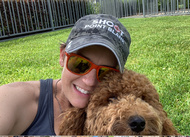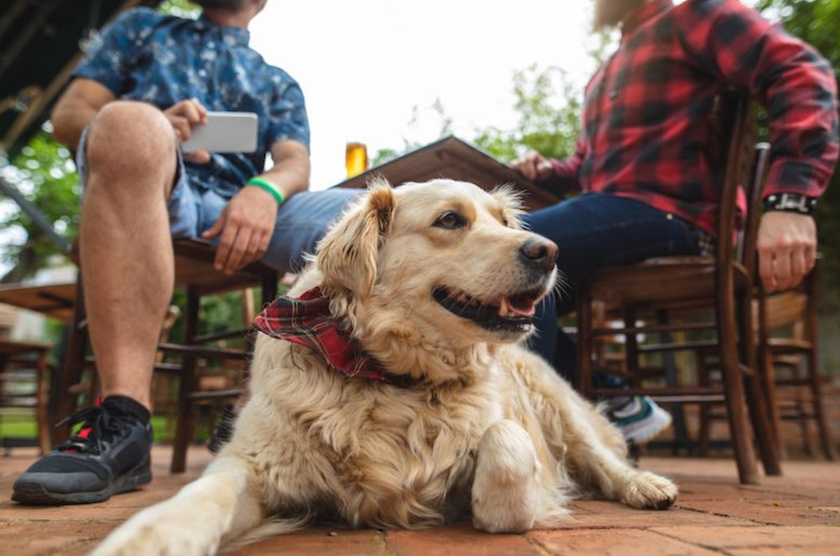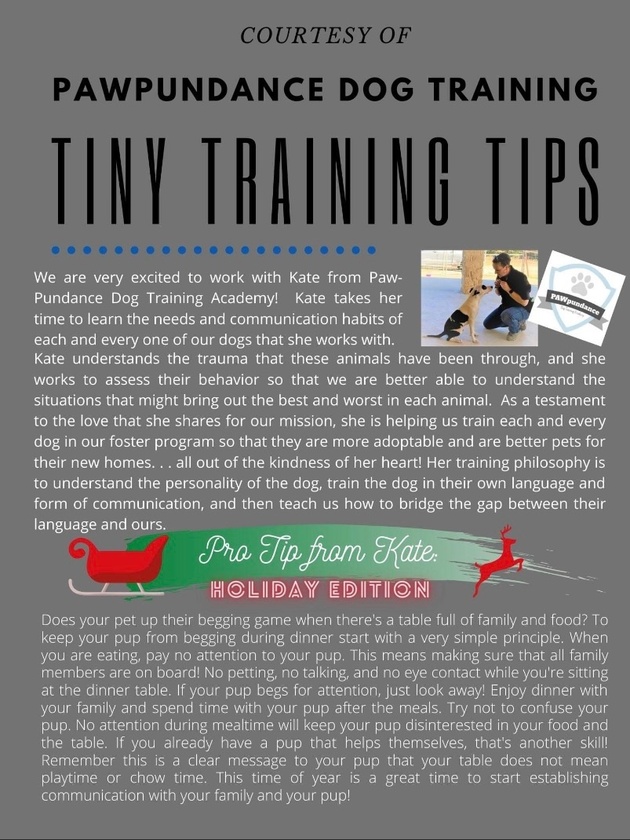
It’s ok! We’re here to help. We speak a little dog and can help translate for both of you. It’s probably just a miscommunication! And we are here to help get you both speaking the same language! Woof!
Connect with the PAWpundance training team and other members of the dog community to discuss better ways to communicate with your furry house guest.
**To get started USE code: TRIAL1month **
Training Loose Leash
Why do dogs pull? Because you follow! One thing you can do, change direction!
Let's talk about the leash. The leash is not a form of communication. Pulling and yanking on the leash to try to let the pup know to go this way or that way... not ok. Let's stop doing this. NOW! Talk to your dog. If you need your dog to stop or change direction, just say so. How hard is that? Why do we need to harm and coerce? The leash is ONLY there for safety. It's to make sure the pup observes the appropriate distance from you, especially while they are learning. If you are in the learning phase, it's to help manage during the walk. And the it observe the city laws and ordinances. So keep the leash. It's there for a reason, even if your dog is perfect - safety first. I like having a leash with a traffic handle when I'm in a city. Even if my pup knows a perfect loose leash walk, I like having that handle so I can grab it if necessary for safety. I like a six foot leash with a traffic handle, not retractable. When in close public places, hold the traffic handle, even if your pup does loose-leash. The leash is for safety - and this is about safety. The horror videos of dogs getting their leashes caught in the elevator doors. But I've also seen dog fights in the elevators and in high-rise lobbies. The best practice is just to hold the handle for safety in the close spaces. When you are across the street, go back to loose leash. To be clear, the leash is never about communicating instructions to the pup. It is always about the safety of the pup.
And that leads me to the collar. I like Martingales. I like martingales because it trains pup and human. Martingales are fitted to be loose. The pups should feel the collar so it's hanging, dangling near their collarbones/shoulder - when the pup is walking in loose-leash. If you have a pup in a regular collar and it's fitted this loose, as soon as the pup decides not to walk with you anymore - they pull out of the collar. In a martingale, when the dog pulls the collar can tighten but unlike a choke chain, it stops. When fitted correctly, it tightens only to the point of a snug collar such that the pup can't wiggle loose. It's also called a "limited-slip" collar. It's great for safety knowing pups won't get loose.
I like the human training aspect of the martingale. When the pup is walking loose-leash, the clasp hangs low around the pups neck. As soon as the pups start to move ahead or away, the clasp begins to spin around their neck and up their back. If it's on their back, it's too late. I like to tell them to watch and as soon as it starts to move towards them, they need to start talking to their pups. They need to ask for eye contact before the clasp reaches their back. It teaches the human to watch their pup and learn to have a two-way communication with their pup on the walk. But also to talk to their pup. They also learn to reward they pup for eye contact. Eventually we teach them that even just a smile is a reward for eye contact. And it's a joy to see pups out there smiling and walking and the humans learn to smile back. (Yes, dogs smile.)
The important thing for the pups is learning the feel of the collar. When I was learning to fly, the important part of landing was learning what the picture was like before landing. It's not intuitive but eventually you learn what the picture should look like. Then it becomes more natural. For the pups, collars are not something natural for them. If anything, it's more instinctual for them to pull and do "work". But having the martingale hanging loose, helps them learn to have a loose feeling on their neck and to be walking next to you within 6 feet - that is the picture they need to create. Every time they create this picture we reward. And the longer they can hold this picture, we reward. We do this until we get a longer walk established. In the times during the walk when the pup is not walking in this picture, we like to have the pups in a harness so we can manage. We will not use the martingale to manage during a walk when the training is over. In the beginning, when the training is done, don't try to force or yank the martingale. Switch over to the harness, go do some sniffing and then go back home holding the traffic handle across the street and through the buildings. Lots of chatter about which is best. I will only speak to my favorite collars. This means all others (prong, choke, slip, shock etc) I don't approve. I don't want to spend my time debating others. I will just speak to why I like favorites - "No attention to bad behavior." I like the front-lead harness for a dog that already has a habit of pulling. If this is the case, then use this harness while managing and even sometimes during training, to leverage the strength of the pup and not harm the pups neck. If your pup already has a habit of pulling, you can't begin training in a martingale. If you do this, your pup will have excessive pressure on his trachea for the majority of the training session. ANY pressure on the trachea can cause damage. Yes, dogs have tough muscular necks - compared to us. But their necks can still be damaged if they exposed to pressure on their necks. If you are needing to hold the leash to balance the pressure of pulling, please use a harness.
What is training vs management? When we train, we are clearing working on defined concepts with clear objectives. When the pup has reached a stopping point and shown signs of either saturation or jackpots, we stops. Saturation means the pup is like a sponge and their little brain has soaked up all the knowledge it's going to take for today. It does not matter what was planned. We are done. How can we tell? Fidgeting, scratching, sniffing, looking away, panting, basic stress signals begin to increase. Instead of seeming engaged, the pup seems more stressed and distant. And when we get there, time to stop. It's the point of diminishing returns. The other time to stop is immediately following a jackpot, or a milestone. If we finally achieve a milestone and then we expect to drill immediately following, it's confusing to the pup. Achieve the milestone and drill in the next session. So after hitting a milestone, we take a break from training and have play time.
So what is management? A lot of time we are out on walks or have time at home that are not training but we need to handle a situation. We need to do a quick potty break. We need to let the maintenance staff in. Some of these instances are not time to train rather they are the times we want our training to kick in. In this case we resort to our lowest level of training. And if we are beginners at loose-leash walking, then we just need to put a harness on and do our best. Eventually the potty breaks will start reflecting the training. The walk back might have a sit here and there and moments of loose-leash. Then gradually the walk back will become smoother and the walk there will become peppered with elements of what you've trained. It's much harder to apply the training when your pup has to pee. So be generous, just get out there. Start adding bits and pieces on the back end and work your way forward. Same thing with the maintenance situation, if you haven't trained impulse control and greeting stranger in your home, this isn't the time. It might be wise just to kennel and give your pup and puzzle or some treat to work until they can calm down. Managing is balancing life with training. Training is best everyday in small sessions. But not every situation is training. Sometimes is best to plan ahead and manage until you're trained and up to speed.
Walking speed is a big deal with pups. If you start walking with your pup young you have the advantage - you can out run/walk them. Once these pups get going, they do not like to slow down. When they hit the ground running, runners have the advantage here. The secret here is to hoof it in the beginning. My husband is the best at teaching loose-leash walking to a new pup. Because that man can walk fast. Walking too slowly will make it harder on the pups. Their natural walking speed is a hustle. So get going. My hubby calls it the secret service run. He does a run that is still kind of a walk in that it's a calm demeanor. Doing this type of walk transitions to a slower walk without an obvious break from run to walk so the pace and slow and speed up as necessary for training. This motivates your pup to walk into a slower walk by more pacing and then leading.
Understanding each step is huge for your pup. Most "disobedience" is probably a lack of understanding the expectations. If you can be clearer in communicating then progress will be faster. One thing to help clarify is to over exaggerate your body language. Image you are trying to communicate to someone that doesn't speak your language. You find yourself over emphasizing every gesture hoping they will help communicate your intentions. Well your dog doesn't not speak human, so let the game of charades begin. It's like a game of hot/cold. You can use positive, motivational energy to communicate and coach a win. But we can't really tell the dog "colder" and punish. The pup will just shut down and won't want to "play" or get mean. So if the pup is getting "colder" or getting of track we give "no attention to bad behavior" or use a "non-reward marker". What is a Non-Reward Marker? I love non-sense phrases. I kinda get it but... what? In simple terms, it's how you communicate "colder" to the pup without shouting "NO!" We keep a happy positive tone. The feeling is, "nope, keep trying!" "Uh-oh!" If said with a sing-song and immediately redirected into the behavior that is garnering a reward, it's effective.
Imagine you are daydreaming in class and the teacher angrily calls your name to answer a question knowingly calling you out. Versus, a teacher waiting for a private moment and sweetly coming up to you and bringing you back to the present and asking you to focus on your assignment. Which teacher sounds like she has it together? Which one is motivating? If you were daydreaming because you were thinking about the assignment or subject and wanted to ask question, which teacher do you feel like you could engage and ask your question? Surely not the one that put you on the spot. If you do, you are an aggressive, tough little kid and she just fostered that - it's not the right kind of tough to foster... dogs or kids.
Motivation is super important. Attention is a huge motivator. Kids, adults, dogs... we all respond to attention. Look at social media if you would like to see the power of attention. Social media is providing dopamine hits comparable to drug and gambling addiction. We can use food as a lure but attention is a huge reward. We have done many loose leash trainings with no food. Food helps when we are struggling to keep the pups attention in a busy park. At that point, it's mostly a lure. Lure training is the most fragile of the positive based training. This is because the pup is focused on the food and not the concept. So I might present the treat so the pup knows I have it, but I never have it like the carrot on the stick unless we are doing serious behavioral training and that's totally different. When we are doing behavioral training, it's like letting the treats rain from the heavens above.
So when you are doing leash training, make sure you are not pulling on the leash to communicate with your pup. There's no Morris code between you two. Exercise caution and hold the traffic handle in closed spaced. No dog-dog introductions in these small spaces. Save it for the dog park. It's small space. They're stressed. They're on a leash and don't have freedom of movement. And two humans that's don't read dog movement are forcing their noses together. Just because the two humans like each other, doesn't mean the dogs have to as well. Save it for the dog park. Let the meet on a neutral turf. If someone else tries to put their dog in your dogs face, body block and tell them no. You can protect your dog. Just walk away and be polite in the dog park.
When your dog is walking loose leash next to you one day, this will be a huge joy. Add the auto-sit when you stop and the bond you have with your dog will be clear. Our German Shepherd -Chow, Linux was fantastic at loose leash. When my 5 year old nieces would stay with us in our downtown high-rise, we would ask which dog would you like to walk (we have three)? The biggest dog was linux (90lb). And my niece, Lindy loved Linux. She could walk him downtown, through the elevators, across streets, past dogs, food, etc and he never pulled harder than a 5 year old could manage. He was a great dog. While I am still working with my blue heeler, who will pull on a leash but if I take him off the leash will walk perfectly next to me 🤷🏻♀️ and my yorkie - Linux was a great dog and my model loose-leash walker!
Welcome to PAWpundance Dog Training Academy on Locals.com!
We’re thrilled that you’ve joined our community! PAWpundance is a place for positive, dog-loving people to come together, share experiences, and help each other grow. Locals offers an “ad-free experience,” so even a small contribution helps support our tech and keeps our community thriving.
We want to see your furbabies!
We’re here to assist with any questions you may have about training, behavior, and more. At PAWpundance, we believe in blending knowledge with a bit of fun—expect plenty of paws, puns, and maybe even a dance or two! Together, let’s enjoy some laughs and build stronger relationships with our pups.
Our Philosophy:
We’ve invited another species to live in our homes, and our dogs are much more than accessories; they’re our guests. They don’t speak our language, and like in the movie E.T., we don’t want to be the intimidating figures trying to coerce a scared, confused being. Instead, we want to be like ...
Eye Contact, Eye Contact, Eye Contact!
Reward every glance. Start by reinforcing brief glances, then encourage your pup to hold your gaze a bit longer. Gradually phase out your part of the eye contact—your pup will learn to watch you and adapt to your movements naturally. This approach helps them learn to walk with you without relying on leash cues.
Remember, the leash is purely for safety—not for communication.
Take a look at this video with Meghan and Buckee. Buckee is watching Meghan closely, and she rewards him by making eye contact, smiling, and offering treats. Meghan also looks forward occasionally, teaching Buckee to walk with her in sync.
Notice that Buckee is a reactive pup, so the leash is essential for safety, especially if he responds to something unexpectedly. However, it’s only used for physical control when necessary. When Buckee refocuses, Meghan reestablishes instructional control, and they continue their walk together. She does a fantastic job of engaging with him! In ...
Loose-Leash Walking Tip:
Where you reward makes a big difference! Try using the hand on the same side as your dog when giving treats or praise.
When you reach across your body to reward with the opposite hand, it draws your dog’s nose in front of you, encouraging them to move ahead and potentially start pulling.
In the video of Meghan and Domino, Meghan holds the leash with her left hand while Domino walks on her right. She rewards him by petting and giving treats with her right hand. This keeps Domino walking by her side on a loose leash, rather than in front, pulling her along.
Next time you’re out walking with your pup, try rewarding with the hand on the same side as your dog.
https://twitter.com/wholedogjournal/status/1295508215740932098?s=21
How to teach you pup to be a good dining companion! What a great skill!

https://twitter.com/wholedogjournal/status/1292609106637987840?s=21
This is about counter-surfers, but I love the description of trying to shame dogs. This author, Pat Miller helped me understand this concept in her book the Power of Positive Dog Training.
If you’re still on Twitter, the Whole Dog Journal is a great group to follow. Lots of fantastic info!













